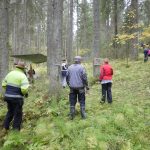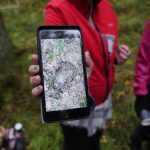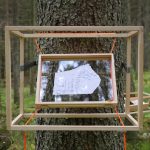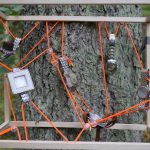Returning from an intensive tour with waters. Between 22.-24. September we complied a project with Tea Andreoletti commissioned by the Instytut Kultury Miejskiej organisation for the opening of their new facilities at Kunszt Wodny in Gdańsk. For the opening event, we prepared and bottled 300 flasks of “Wypij Morze!” (Drink Sea!) carbonated mineral water which was served for guests from a “Bar (Słono)Wodny” meaning (Sea)Water bar. In all we produced 250 litres of the bespoken drink and supplied the audience with tap waters from around the city. There were a lot of performances, architectural light shows and sound/music at the opening event… Most of which referred to the sea and waters in different ways. The building is at the site of a historic watermill.
We prepared the project during the summer and we visited the city in August for research. The recipe of Wypij Morze! was drafted on the first trip in a meeting with Institute of Oceanology PAN scientists (Tymon Zielinski, Tomasz Kijewski & Aleksandra Koroza) and the Gdańska Infrastruktura Wodociągowo-Kanalizacyjna (GIWK) staff, who are responsible for the city drinking water affairs. The project was curated by Anna Mitus and produced by Anna Kwiatkowska (IKM) who handled both the production and the intensive field excursions, which took us all around the city between the strange shoreside of Rewa (where we collected seawater for consumption) and suburbs of Urunia. Natalia Cyrzan (IKM) worked on the back end of the project establishing and facilitating exchange with GIWK, the Institute of Oceanology and a tip:tap, a Berlin based NGO also working on a (tap)waterbar initiative. In addition to the performance we also took part in a breakfast seminar discussing sea & drinking water affairs and hosted a workshop for children where they could design bottle labels.

Ingredients for Wypij Morze!
1l/g Instytut Kultury Miejskiej Tap Water
NaCl (Table salt) 2,4
MgSO₄ (Epsom salt) 2
NaHCO₃ (Baking soda) 1,1
CaSO4 (Gypsum) 0,4
Mg(OH)2 (Magnesium hydroxide) 0,4
Ca (Calcium) 0,2
KC₄H₅O₆ (Cream of Tartar) 0,1
Our project explored the diversity of tap waters, water as commons, infrastructures’ relationship with domestic spaces and how changes brought about by rising sea levels will affect the latter. Gdańsk has a complex history with water (featuring sewage innovations), wells, mills and canals which were introduced to by GIWK.
For me and Tea this project was a continuation of the previous Waterbar/Spring -excursions but the scale of what we prepared for Gdańsk was grandiose and depended on a close exchange with local artists. This facet of the project was elegantly planned and organised by Mitus. The Bar (Słono)Wodny, which served as a main stage of our performance was built to the main hall of the Kunszt Wodny building. It was a geology inspired bastion-bar-counter built for the project by artists Krzysztof Surmacz and Daniel Sobański. Wypij Morze! was served to people in three different fancy glass bottles which prints were designed by artists Alina Mielnik, Kamil Kak and Karol Polak. Each produced their own design but they all contained the same drink.
Mielnik’s illustration offers hope for a submerged city, Kak’s bottle design performs the sinking of Gdanśk on every gulp and Polak produced a semiotic atomisation which broke the heavy content of the drink into a digestible mess.

At the Bar (Słono)Wodny, Tea shared their skills in tasting and we presented the raw minerals of Wypij Morze! explaining it to be “the taste of the future”. In exchanges with guests we explained that the drink had “magnesium for stamina so that we can hold your breath under water” and that it had extra calcium to “make your bones into beautiful fossils”. These macabre sales speeches worked as a segue to imagine the current state of the Baltic, contamination and future of coastline cities. The Institute of Oceanology predicts that Gdańsk may be swallowed by the sea as continental ice sheets melt. Inviting people to drink sea, as a responce to climate change gave me gothic-horror-thrills and the narrative was backed by an installation with various mineral and high pressure gas equipment placed on the bar counters. During our August trip we carried the carbonisation tools with us when exploring the city, appearing as scuba divers.

At the bar we also handed out tap-water drinks, the most popular of which was “Domowa od Ani z lodem” (Anna Kwiatkowska’s home tap) and “Jaskinia Batmana (Orunia)”, which was inspired by our visit to the Stara Orunia Reservoir, which currently serves as a bat dormitory. Our August visit to the reservoir was facilitated by GIWK who provided us with a detailed history of the city’s drinking water infrastructure. “Domowa od Ani z lodem” drink was the centrepiece of our bar-installation, illuminated by a led lamp and luring people like a lighthouse. A simple and effective flopping of public and private spheres, the added tension of all the waters being prepared by the same public infrastructure company.
The bar also included a soundscape which consisted of processed sounds of carbonisation (benjolin&twinpeaks&delaynomore!) and wave-drinking sounds. Tomek the light/sound designer is also to thank for the look of the bar. Anna M. also published a text on the project later on which is available in Polish.

Returned from Gdańsk on a bus (26h) and prepared an installation for Drifts -festival which was led by artist directors Giovanna Esposito Yussif & Soko Hwang. On the opening day on Saturday I presented the “Our Grand Water Treatment Plant” installation composed of ceramics, minerals and pumps. A centre piece was a makeshift water filter system which circulated tap water through natural stones collected from the Kurängen spring, altering its composition. I also prepared pebbles for people to taste. The modular installation was exhibited on old water pumps found at the “Filterhall” room of the Museum of Technology in Vanhakaupunki. The filterhall is the site where the drinking water of Helsinki was supplied from before the Päijännetunneli was opened. I guess the theme of the festival called for our own water infrastructure initiative.
Our Grand Water Treatment Plant was built from the same building blocks as the installation at the The Surface Holds Depths -exhibition at Lappeenranta Art Museum (curated by Miina Hujala) and wooden frames first used as props for the “The Forest Spring Affair” performance in Sipoonkorpi late 2022 . One frame showed ceramics made from wild clay collected with the Nomadic Kiln Group (Monika Czyżyk & Elina Vainio) and I also included a ceramic whisk which housed a bacterial cellulose membrane (which removes oil traces from the water) that was prepared under the supervision of artist Alexey Buldakov.

On Sunday I gave a lecture performance discussing drinking waters using the same notes as during the Kiilan äänipäivä performance in 2022 (I think I’ve now performed everything I can imagine with this piece) and I also supplied the audience with 22 liters of Wypij Morze! during the festival.
Drifts succeeded in inviting a lot of great artists and managing large crowds. My absolute favourite was bela from Berlin who hardcore screamed through a theatrical act. The sound system of the space (or perhaps the curatorial plan) favoured descant tones and most concerts utilized some kind of whipping clash-crashes. This served bela well and Kaino Wennerstrand’s phaser effected acoustic guitar riffs too! Most of the sets were didactic and deployed aestheticized glitches for the spoken word bits. Most performers used automated computer processes. There was no rage in analog form. The bass was good too but most complex and interesting events took place in high registers.
An Tul was a touching new act for me. They performed outdoors with intensive charisma establishing a stage by their mere stances. They showed humour with out joke and offered intuitive nature interactions (a flock took their set as a cue for starting their winter migration). I had very high expectations for Nkisi on Sunday because I just learned about their work from a Techno at the End of the Future, Episode 1: London podcast. The set had a positive-gabber vibe but I didn’t get on a rhythm high.
There was a screening too. The Otolith Group’s “Hydra Decapita” (2010) was great to see and served as a perfect finale for my water-tour-vibes because they utilized short wave radio tones in their artistic documentary detailing Drexciya (Our Bar (Słono)Wodny soundscape also had a SW segment!).















